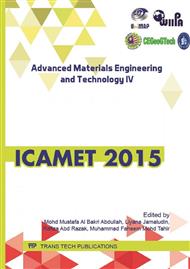[1]
X. Kong, X. Liu, and Y. Yang, Y: Advances in pharmacological research of eugenol. Curr Opin Complement Alternet Med Vol 1 (2014), pp.8-11.
Google Scholar
[2]
N. Chaibakhsh, M. Basri, S.H. Mohamed Anuar, M.B. Abdul Rahman and M. Rezayee: Optimization of enzymatic synthesis of eugenol ester using statistical approaches. Biocatalysis and Agricultural Biotechnology Vol 1 (2012), pp.226-231.
DOI: 10.1016/j.bcab.2012.03.005
Google Scholar
[3]
Information on http: /www. nlm. nih. gov/medlineplus/druginfo/natural/251. html. Accessed in March 10, (2014).
Google Scholar
[4]
P.K. Guy, I. Vermaak, M. Alvaro and Viljoen : Eugenol – from the remote Maluku Island to the International market place: a review of a remarkable and versatile molecule. Molecules, Vol 17 (2012), pp.6953-6981.
DOI: 10.3390/molecules17066953
Google Scholar
[5]
J. Li, Y. Yu, Y. Yang, X. Liu, J. Zhang, B. Li, X. Zhou, J. Niu, X. Wei and Z. Liu : A 15-day oral dose toxicity study of aspirin eugenol ester in Wistar rats. Food and Chemical Toxicology, Vol 50 (2012) p.1980-(1985).
DOI: 10.1016/j.fct.2012.03.080
Google Scholar
[6]
K.M.W. Syamsul, M.R. Salina, S.S. Othman, M.N. Hanina and M.B. Abdul Rahman : Optimization of Lipase Catalyzed Synthesis of Nonyl Caprylate using Response Surface Methodology (RSM). Biotechnology and Biomaterials Vol 1 (2011) pp.1-5.
DOI: 10.4172/2155-952x.1000106
Google Scholar
[7]
E.R. Gunawan, M. Basri, M.B. Abdul Rahman, A.B. Salleh, and R.N.Z. Raja Abdul Rahman : 2005. Study on response surface methodology (RSM) of lipase-catalyzed synthesis of palm-based wax ester. Enzyme and Microbial Technology, Vol 37 (7) (2005).
DOI: 10.1016/j.enzmictec.2005.04.010
Google Scholar
[8]
S. Mat Radzi, K.M.W. Syamsul, S.S. Othman, M.B. Abdul Rahman and H. Mohd Noor : 2011. Optimization of lipase catalyzed synthesis of ethyl valerate, a green apple flavor using Response Surface Methodology (RSM). Journal of Environmental Science and Engineering, Vol 5 (2011).
Google Scholar
[9]
X. Ding, B.F. Rasmussen, G.A. Petsko, and D. Ringe : Direct crystallographic observation of an acyl-enzyme intermediate in the elastase-catalyzed hydrolysis of a peptidyl ester substrate: Exploiting the glass transition, in protein dynamics. Bioorganic Chemistry Vol 34 (2006).
DOI: 10.1016/j.bioorg.2006.10.002
Google Scholar
[10]
W.D. Chiang, S.W. Chang and C.J. Shiah : 003. Studies on the optimized lipase-catalyzed biosynthesis of cis-3-hexen-1-yl acetate in n-hexane. Process Biochem, Vol 38 (8) (2003) pp.1193-1199.
DOI: 10.1016/s0032-9592(02)00281-9
Google Scholar
[11]
S. Harikrisna, A.P. Sattur and N.G. Karant : Lipase-catalyzed synthesis of isoamyl isobutyrate optimization using central composite rotatable design. Process Biochem, Vol 37 (1)(2001) pp.9-16.
DOI: 10.1016/s0032-9592(01)00161-3
Google Scholar


